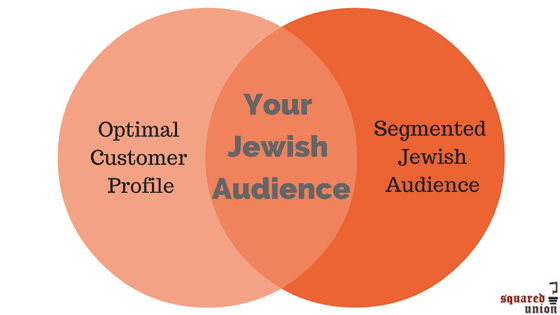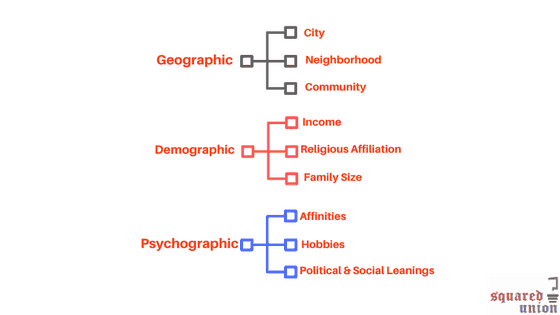Segmenting The Jewish Audience: It’s All In The Details
Often, when it comes to growth goals, businesses are searching for “the holy grail;” the marketing strategy that will simply be like a magic pill and instantaneously power them, express-style to success. While such a marketing magic trick would undoubtedly be fantastical, it is just that. However, there is one technique that reliably works wonders when employed by those trying to reach the Jewish audience.
The technique we reference is “audience segmentation.” While segmentation in the marketing context has been around for what may seem like an eternity, using this marketing methodology for campaigns aimed at reaching the Jewish audience is of particular importance, mainly because of the more nuanced nature of Jewish centric campaigns. For marketing campaigns of all shapes and sizes, segmentation provides several clear advantages, which has led to its widespread adoption. When executed correctly in marketing campaigns targeting the Jewish audience, one can see its benefits and associated returns multiplied over time.
The potential for reward from an adequately executed segmented Jewish marketing campaign is alluring, but the glaring caveat is always the same. Proper execution, especially when it comes to such an intricate task of segmentation, contains within it the potential for making substantial errors that will render the campaign ineffective and providing for little or no return.
Why Jewish Audience Segmentation Is Advantageous
The core reason for segmenting audiences’ effectiveness in preparation for a campaign revolves around zoning in on the optimal audience most relevant to the offering. Further, by categorizing differing audiences, specific messaging can be crafted for each, leading to a more receptiveness. Such a tailored approach ensures that marketing efforts have a better chance at a positive return.
The four scenarios we list below show a particular advantage in performing segmentation in the Jewish marketing context.
- An Offering With Audience Specific Relevance – Certain products or services do not appeal to the broader population and need to be marketed only to their relevant segment. For example, marketing airfare and other travel-related services in preparation for the Jewish holiday of Passover relates only to specific subsets of the Jewish audience and would not be of any interest to the general audience. In such a campaign segmenting the Jewish audience along religious lines, wealth, and other data points are of particular importance. In contrast, marketing of a general technology product with broad market appeal lacks the same need for a breakdown of audience types. With that said, such a technology offering would still likely see advantages from segmentation by tailoring its message differing audiences but more on that a bit later on in this discussion.
- Nuanced Messaging Needed – Sometimes, an offering is relevant to the broader general audience. However, it requires different messaging for varying subsets of the general population. For example, a stovetop oven with numerous features would be wise to tout the material advantage to the corresponding community. A built-in cooking apparatus might speak to populations of particular ethnicity that enjoy traditional foods that are cooked best via that apparatus. Simultaneously, audiences made up of families might respond best to ad messaging touting the appliance’s child safety features. Still, the Jewish audience might be most likely to purchase if served a marketing line that stresses the capabilities related to accommodating those who are observant of the Jewish Sabbath via a Sabbath mode. By segmenting these very different audiences and tailoring the messaging that will best relate to that specific group, a better response is likely.
- Using Limited Resources Strategically – There is also a unique advantage that comes through marketing segmentation in terms of being able to make a better spend of limited resources. Instead of marketing to the general population, by honing in on an offerings optimal audience and targeting accordingly, one can make their marketing dollar a lot further. Strategic utilization of limited budget takes on even more significance for Jewish focused campaigns. Separating the broader Jewish demographic into smaller subsets that might be more suitable to the offering will limit wasted spend and increase returns.
- Experimenting and Exploring New Opportunities – The previous three scenarios provide for straightforward rationales of the advantages of performing segmentation in Jewish marketing. Here we outline a less obvious potential advantage. By breaking down broader audiences into smaller substrata and testing corresponding ads, businesses can gain a unique understanding of their customers. Data of this kind that is concrete offers valuable insight for identifying growth opportunities. Fine-tuning campaign machinations with a laser-like aptitude become possible by seeing how different Jewish audiences respond to messaging and varying offerings.
Such metrics also allow for gauging of consumer demand as well as for expansion into new offerings. Often, the only way to do this is to segment-specific campaigns that bring customer needs and wants to the surface. Thinking along these lines sets a business apart from the competition and acts as a driver of growth.
In addition to the four scenarios and associated advantages listed above, segmentation also allows for a better approach to the traditional “Four P’s of Marketing.”
- Price – Offering and pricing structure must account for the variety of Jewish audiences across the spectrum, including wealth profiles and related demographic markers. For example, offering both budget and luxurious options will do well to tout their more economical offer to a budget-conscious audience. On the other hand, while marketing to a wealthier audience, promoting their pricier but more luxurious option will likely enhance the desired response.
- Place – It is also wise to consider the places (platforms) that will most effectively reach the identified target audience. Such variance will and should vary depending on the audience. As an illustration, if for a particular campaign, the optimal segment is Jewish moms, perhaps having Pinterest, a platform popular with mothers, should be utilized.
- Product – When it comes to the actual product or service on offer, segmentation also helps to differentiate the messaging of product features. As discussed previously, when marketing an appliance to a Jewish segment, stressing features that take into account religious obligations for those who keep the Jewish Sabbath will be a more convincing offer than merely a product that offers general appliance features.
- Promotion – Strategically forming campaign messaging and associated general promotion while considering specific sensitivities of particular Jewish audiences and related intricacies also play a big part in a broader segmentation strategy. By splitting up different parts of the Jewish audience, promotional aspects that speak more effectively to one subset can be used for that audience. Using a different promotional strategy that speaks more effectively to a separate subgroup can be used for the other.
Before Embarking On Marketing Segmentation
-
- Measurable – Before beginning to segment your Jewish audience, or any audience for that matter, it is vital to understand whether the audience you are trying to reach is measurable. Specifically, ascertaining whether it is possible to craft the broader audience into a measurable and separate subset. The more nuanced and specific one gets when it comes to segmenting, the more difficult it becomes to accurately measure it. This is one of the most common pitfalls of segmentation, where it is taken to an extreme and becomes impractical and unrealistic to be employed as a useful technique.
- Actionable – Once it has been confirmed that the segmentation strategy is measurable, the next question should be whether the segmented audience is actionable. Put more succinctly, even with an adequately segmented audience, is there a marketing campaign that can be effectively and efficiently launched based on the segment. Is the return going to be worth the investment? Often, if the segmented audience is too small, it will be tough to measure, but it will also lack potential and not be actionable.
- Accessible – And lastly, even after both measurement and actionability have been positively determined, there must be a way to access the segment. To elaborate, is there a way to reach this particular and focused grouping of the Jewish audience in a manner that will provide for a positive return. This is an important question to answer when embarking on the process. Even with a properly executed strategy in terms of measurement and action, if there is no way to market to the segment, then the effort will be for naught.
A Precursor To Proper Segmenting: Establish Your Optimal Customer Profile
The first step in segmenting for Jewish centered marketing campaigns is understanding who makes up your optimal target customer within the broader Jewish community. Identifying the optimal customer persona is a two-pronged analysis. First, focus on your offering’s details and potential selling points and second how they correspond to the various subgroups of the broader Jewish audience. By stressing your product or service’s essence and focusing on the most relevant groups, the optimal audience(s) profiles are formed. The result may include a combination of geographical area, age range, wealth bracket, as well as numerous other demographic or psychographic markers.
The Example: Jewish Audience Segmentation In Practical Terms
Taking a specific example to better illustrate market segmentation in a Jewish-centered ad campaign will be helpful. Going forward, we will be discussing a scenario where a premium cruise operator would like to expand its customer base within the Jewish market. The company is looking to tout its kosher food options, family-friendly activities, and sensitivity to Jewish religious requirements.
The First Step: Creating Your Optimal Customer Profile
When creating the persona, the main features that should stand out about the cruise offering previously described are as follows:
- Premium Offering: The optimal customer profile will be a consumer with considerable discretionary income, denoted by the cruise’s premium nature demanding a higher price point.
- Kosher Food: With kosher food being one of the front and center selling points that the cruise operator is promoting to attract Jewish customers, seeking out a Jewish audience that keeps kosher laws is essential. While the cruise may speak to less observant Jewish communities, it is astute to hone in on a segment that will be uniquely enthusiastic about the kosher aspect.
- Family Friendly: While the family-friendly slant of the cruise can undoubtedly appeal to numerous audiences, both Jewish and not, for this Jewish centered campaign, identifying a customer persona that will be excited about the familial atmosphere is vital. Utilizing targeting capabilities focused on younger families or perhaps grandparents that would be interested in taking the younger generation on a cruise will drive positive results.
- Sensitivity For Jewish Religious Requirements: Few things can turn a vacation sour like a bad experience relating to their religious practices’ insensitivity. After all, their religious life is one of the most personal and sensitive areas for many. Experiencing a cruise where the staff is both knowledgeable and understanding as well as willing to accommodate seamlessly to a guest’s religious observance is very attractive to such consumers. Stressing this part of the offering can play a significant differentiating advantage over the competition. Therefore, it would be strategically beneficial to capitalize on this point and seek to market to a religious and observant Jewish segment.
A Review: Creating Customer Personas
It is helpful to review the dynamics involved in crafting customer personas. First, analyze who within the larger Jewish audience would be most interested in such a product or service. Specifically, identify the offering’s key selling points and find the corresponding segment that would see the features most attractive. In the cruise operator’s scenario, the offering is on the higher end of the spectrum when it comes to price. Therefore, the offering’s marketing should be to a segment of the broader Jewish audience with the requisite spending ability. Further, as there is also kosher food on offer, the cruise would be of special interest to a kosher conscious consumer and should be routed accordingly. Lastly, the cruise is also family-friendly and sensitive to religious requirements, which will further direct the campaign to focus on reaching a religious and family-centric demographic.
While we only explored the most apparent and fundamental aspects of the cruise offering in the example for coming up with the optimal customer profile, it lays out the core approach for conducting successful segmentation.
Applying Customer Personas To Segmentation Efforts
Once the optimal customer profiles are established, the next step is matching them with the corresponding Jewish audiences. The matching of the two is, in our opinion, the stage where the most significant challenges and room for error lie. While it is somewhat self intuitive to create a customer profile based on the in-depth knowledge of one’s offering, knowing the many different Jewish audiences’ minutia is more complicated and the experience less likely to be possessed by the average business.
It is helpful to explore some of the most common points of segmentation and how they relate to the sample customer profile we created based on the example of the cruise.
- Geographic Location: Segmentation based on geographic location is one of the most common aspects of audience breakdown used. Targeting can be as broad as profiles matching residency in a country or as specific as a neighborhood. In the example scenario, it might be advantageous to market to Jewish communities in proximity to the cruise departure location or a zipcode with higher than average wealth brackets.
- Religious Affiliation: Properly formulated marketing campaigns trying to reach a Jewish audience are likely to have some segmented aspect revolving around religious observance. Whether it be a CPG, hospitality-related offering, or anything in between, it is often helpful to analyze which Jewish community would be most suitable based on religious affiliation. Some offerings will be of unique relevance to Orthodox Jews, while others may be more appropriate for the Conservative or Reform segments. In the example of the cruise, the kosher food, combined with the family-oriented atmosphere and religious sensitivities, should translate into focusing on more religious Jewish segments. Utilizing platforms that cater to the identified religious group and employing a host of other creative data markers such as synonymous affinities allows for effective honing.
- General Demographics Markers: In addition to location and religion, there is a multitude of other demographic details that one can use to segment the Jewish audience. While all markers work in conjunction with the best segment to target, some of the additional data points include general things like wealth, language, and employment type.
- Psychographics & Other Affinities: Psychographic markers can also be employed advantageously. Some of the main points to consider includes the profile’s political leanings, social and charitable affinities, and hobbies. Taking these aspects of a consumer profile into account becomes especially useful in digital campaigns where these data points about an audience are widely available and utilized in targeting. In the cruise context, it would be wise to use psychographics that center around travel habits and interests relating to similar travel offerings.
- Many Other Possibilities: In addition to the most common segmentation possibilities discussed above, there are many other ways to segment. The options and techniques used depend on the marketing scenario and goals. For example, segmenting can be in tandem with where a potential customer is currently holding within the sales funnel. Such a breakdown can be accomplished through different landing pages and emails. A customer further down in the funnel may be given more prominent CTA’s while a newer prospect may be provided with assets to move them further along the purchase journey.
Not A Mutually Exclusive Strategy
It is important to remember that segmentation for the Jewish audience does not rule out other general marketing or specialty audience marketing. Segmentation between different audiences is not mutually exclusive. There is usually substantial overlap between two separate, but at the same time, overlying segmented audiences. These “hybrid campaigns” are, in fact, commonplace. An offering may be very relevant to both a Jewish or Hispanic audience. It is crucial to craft an appropriate strategy and message for each distinct audience segment in such instances.
Bringing It All Together
For clarity, we summarise the steps for segmentation below:
- Craft the optimal Jewish customer profile based on the offering.
- Match the optimal profile with corresponding Jewish audience segments.
- Create a targeting and messaging strategy that will most effectively and efficiently reach the identified groups.
- Measure and optimize segmentation strategy on an ongoing basis. Recalibrate the approach based on past results, focusing on campaign data to direct decision-making with robust data.
While at the outset segmentation can seem daunting, it leads to positive results that bring substantial returns when properly executed. Keeping in mind that the process is nuanced and not expecting perfection from the beginning while making steady improvements will ensure that progressive gains are possible.




